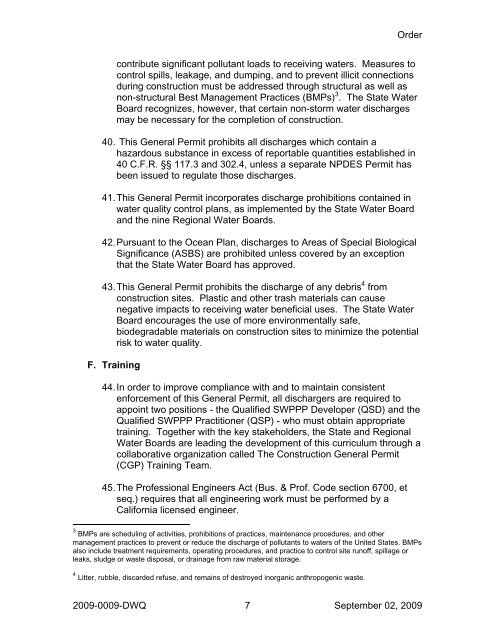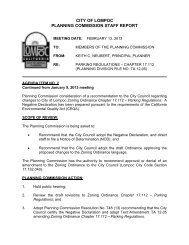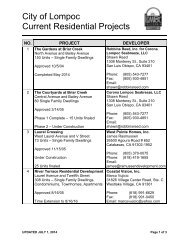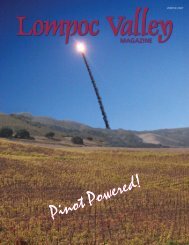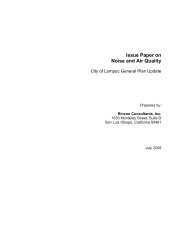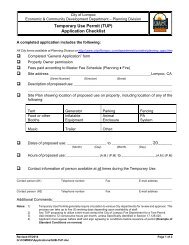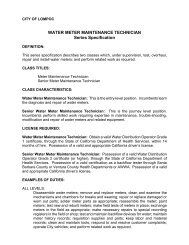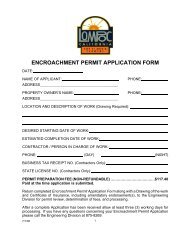Storm Water Pollution Prevention Plan (SWPPP) - the City of Lompoc!
Storm Water Pollution Prevention Plan (SWPPP) - the City of Lompoc!
Storm Water Pollution Prevention Plan (SWPPP) - the City of Lompoc!
Create successful ePaper yourself
Turn your PDF publications into a flip-book with our unique Google optimized e-Paper software.
Ordercontribute significant pollutant loads to receiving waters. Measures tocontrol spills, leakage, and dumping, and to prevent illicit connectionsduring construction must be addressed through structural as well asnon-structural Best Management Practices (BMPs) 3 . The State <strong>Water</strong>Board recognizes, however, that certain non-storm water dischargesmay be necessary for <strong>the</strong> completion <strong>of</strong> construction.40. This General Permit prohibits all discharges which contain ahazardous substance in excess <strong>of</strong> reportable quantities established in40 C.F.R. §§ 117.3 and 302.4, unless a separate NPDES Permit hasbeen issued to regulate those discharges.41. This General Permit incorporates discharge prohibitions contained inwater quality control plans, as implemented by <strong>the</strong> State <strong>Water</strong> Boardand <strong>the</strong> nine Regional <strong>Water</strong> Boards.42. Pursuant to <strong>the</strong> Ocean <strong>Plan</strong>, discharges to Areas <strong>of</strong> Special BiologicalSignificance (ASBS) are prohibited unless covered by an exceptionthat <strong>the</strong> State <strong>Water</strong> Board has approved.43. This General Permit prohibits <strong>the</strong> discharge <strong>of</strong> any debris 4 fromconstruction sites. Plastic and o<strong>the</strong>r trash materials can causenegative impacts to receiving water beneficial uses. The State <strong>Water</strong>Board encourages <strong>the</strong> use <strong>of</strong> more environmentally safe,biodegradable materials on construction sites to minimize <strong>the</strong> potentialrisk to water quality.F. Training44. In order to improve compliance with and to maintain consistentenforcement <strong>of</strong> this General Permit, all dischargers are required toappoint two positions - <strong>the</strong> Qualified <strong>SWPPP</strong> Developer (QSD) and <strong>the</strong>Qualified <strong>SWPPP</strong> Practitioner (QSP) - who must obtain appropriatetraining. Toge<strong>the</strong>r with <strong>the</strong> key stakeholders, <strong>the</strong> State and Regional<strong>Water</strong> Boards are leading <strong>the</strong> development <strong>of</strong> this curriculum through acollaborative organization called The Construction General Permit(CGP) Training Team.45. The Pr<strong>of</strong>essional Engineers Act (Bus. & Pr<strong>of</strong>. Code section 6700, etseq.) requires that all engineering work must be performed by aCalifornia licensed engineer.3 BMPs are scheduling <strong>of</strong> activities, prohibitions <strong>of</strong> practices, maintenance procedures, and o<strong>the</strong>rmanagement practices to prevent or reduce <strong>the</strong> discharge <strong>of</strong> pollutants to waters <strong>of</strong> <strong>the</strong> United States. BMPsalso include treatment requirements, operating procedures, and practice to control site run<strong>of</strong>f, spillage orleaks, sludge or waste disposal, or drainage from raw material storage.4 Litter, rubble, discarded refuse, and remains <strong>of</strong> destroyed inorganic anthropogenic waste.2009-0009-DWQ 7 September 02, 2009


